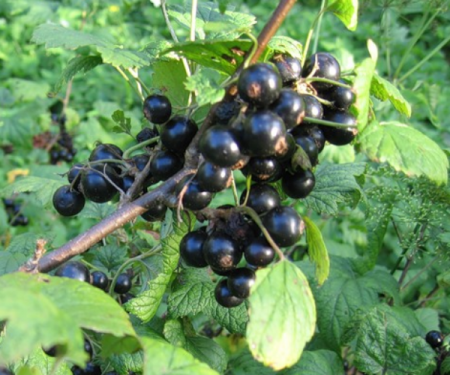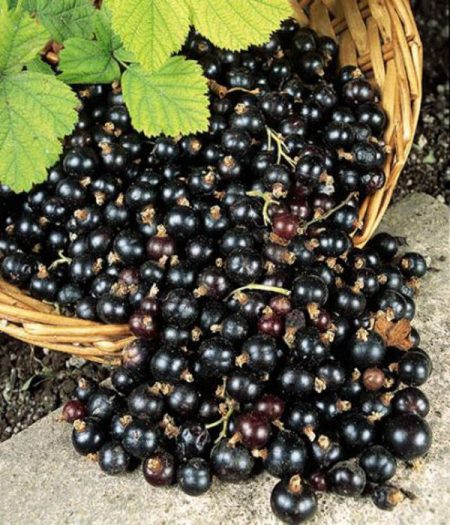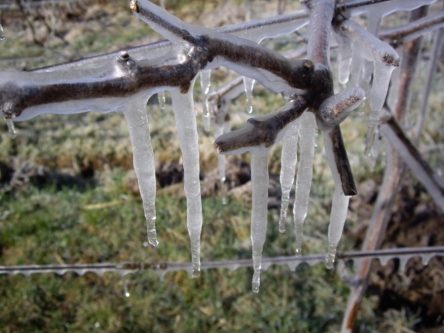Currant Leningrad giant
Leningrad giant is a very old Soviet variety, obtained at the Leningrad Agricultural Institute by breeders Glebova and Potashova. In 1974, the Leningrad giant was zoned in 3 regions of the Non-Black Earth Region.Currently it is not in the State Register; seedlings can only be found from collectors.
Description of the variety
Currant Leningrad giant of medium early ripening. The bushes are erect, tall, and become spreading when fruiting. The young growth is thick, the buds are also thick and short, reddish in color, this is a distinctive feature of the variety. The berries are medium, round, black, shiny. The pulp is aromatic, juicy, tender, sweet and sour taste. A dessert variety, suitable for fresh consumption, processing, transportation, and freezing.
- high yield - 3.5-4.0 kg/bush;
- berry weight 1.2-2.2 g;
- substance content: sugar 7.1-12.7%; acids 2.4-7.5. Their maintenance depends on weather conditions and cultivation technology;
- the vitamin C content is 155-254 mg/100 g and directly depends on weather conditions.
Advantages.
- high winter hardiness;
- good yield;
- transportability;
- good taste;
- The Leningrad giant is resistant to anthracnose and relatively resistant to bud mites;
- terry resistant.
Flaws.
- insufficient self-fertility;
- the variety is severely affected by powdery mildew;
- demanding conditions for growing;
- flowers are severely damaged by spring frosts;
- branches often break under the weight of the harvest.
The Leningrad Giant variety is labor-intensive to grow. To keep the bushes in a healthy condition, regular preventive and therapeutic measures are required. In addition, the self-fertility of the variety is only 50%, and to obtain the yields declared by the originator, it is necessary to plant pollinating varieties.
The name of the variety Leningrad Giant corresponded to its time. In the 70s, berries weighing 2 g were considered very large.Now almost all modern varieties have such a mass of fruits, so the berries of the Leningrad giant are currently classified as medium size.
Features of growing the Leningrad Giant variety,
The Leningrad giant, unlike most blackcurrant varieties, is very demanding in terms of agricultural technology.
Preparing the landing site
The Leningrad giant requires very fertile soils. It grows equally poorly both on poor podzolic soils and on chernozems. When planting currants, rotted manure or humus is added within a radius of 2-3 meters, 2-3 buckets per m2. 6-8 kg of organic matter and 2 tbsp are added to the planting pits. spoons of superphosphate.
Currants do not tolerate alkaline soils. If the soil is highly alkaline, then the Leningrad giant simply will not grow; if it is weakly alkaline, it is alkalized. To do this, planting holes are made slightly deeper and high-moor peat, sawdust, pine litter, humus or fresh manure are added to them. Also, these components are scattered around the perimeter of the bushes with subsequent sealing.
They alkalize the soil for a long time, but quite slowly. Therefore, if possible, work must be carried out 1-2 years before planting currants. If this is not possible, then planting holes are prepared in the fall, and currants are planted in the spring. 10 kg of humus or 3 kg of fresh manure reduces the soil pH by one.
Currant care
The Leningrad giant is not self-fertile enough and for better fruiting it is necessary to plant pollinating varieties. For these purposes, the most suitable early and middle varieties are: Selechenskaya and Selechenskaya 2, Viola, Azhurnaya, Belorusskaya Sladkaya, Barmaley.
In dry summers, the variety needs weekly abundant watering. 2-3 buckets of water are poured under the bush.Also, if the soil is too acidic, after harvesting the bushes are watered with milk of lime. To do this, 0.5 kg of lime is poured into 7-10 liters of water and left for 1-2 days, stirring occasionally. Then the solution is filtered and applied to the bushes, and the sediment can be applied under the cabbage, or scattered on free beds from which the harvest has already been harvested. If the soil is acidic, then it is sour not only under the currants, but throughout the entire area.
If the soil is alkaline, the bushes are watered with a solution of ammonium nitrate or iron sulfate to acidify it. They are also fertilizers, and iron sulfate also protects plants from diseases.
Measures to alkalize or deoxidize the soil under growing bushes are carried out every 3 years.
Every year the variety is fed 2 times per season. During the period of filling berries, the Leningrad giant is sprayed with a solution of any microfertilizer. After harvesting, add 1-2 tbsp. a spoonful of superphosphate and potassium sulfate. If the summer is damp, then fertilizers are applied around the perimeter of the bushes; if it is dry, then watered with a fertilizer solution. But if the soil is very poor, then in the spring, when the leaves bloom, fertilize with nitrogen fertilizers, which are best applied in liquid form.
The variety suffers greatly from both late spring and early summer frosts. There is a significant drop of damaged flowers and ovaries. In the event of prolonged frosts, you may be left without a harvest at all.
To protect against frost the night before, the currants are well watered (2-3 buckets under the bush and around the perimeter of the crown) and sprayed generously with water. In the morning, the twigs, flowers and ovaries will be completely covered with ice. This saves them from death. The temperature inside the ice ball is 0°C, and temperatures of -2°C and lower are fatal for the Leningrad giant.
You can protect currants from frost by covering them with a covering material (lutarsil, spunbond) in several layers. You can use rags instead.
Often the shoots of this currant variety cannot withstand the weight of the harvest and break. To prevent this, branches are tied to a support (usually a fence), or bushes are tied. You can place supports under strongly leaning branches.
Fighting powdery mildew
Powdery mildew is the scourge of this currant variety. Since the Leningrad giant is damaged every year, measures to prevent and treat the disease are carried out throughout the season. In this case, folk remedies are extremely weak and ineffective, so even prevention is carried out using chemicals.
In early spring, before the buds open, “blue” spraying of the garden, including currants, is carried out. Before flowering, they are sprayed with HOM and Ordan, then treatments are carried out every 2 weeks, alternating the preparations. Spraying is stopped 20 days before harvest. These drugs are more suitable for preventing the disease. To treat powdery mildew, they should be alternated with systemic fungicides.
If powdery mildew does appear on currants, then treat with colloidal sulfur (Tiovit Jet) or systemic fungicides (Vectra, Topaz, Raek). Currants can be sprayed with sulfur 3 days before harvest. Fungicides are used no later than 3 weeks before picking berries. At least 2 treatments are carried out, alternating drugs.
The Leningrad giant was very good for its time. Now he has lost relevance. Its significant shortcomings nullified all its advantages. Now there are many varieties that are superior to it in all respects.






 (4 ratings, average: 3,50 out of 5)
(4 ratings, average: 3,50 out of 5) CUCUMBERS NEVER GET SICK, I'VE BEEN USING ONLY THIS FOR 40 YEARS! I SHARE A SECRET WITH YOU, CUCUMBERS ARE LIKE THE PICTURE!
CUCUMBERS NEVER GET SICK, I'VE BEEN USING ONLY THIS FOR 40 YEARS! I SHARE A SECRET WITH YOU, CUCUMBERS ARE LIKE THE PICTURE! You can dig a bucket of potatoes from each bush. Do you think these are fairy tales? Watch the video
You can dig a bucket of potatoes from each bush. Do you think these are fairy tales? Watch the video
 How our fellow gardeners work in Korea. There is a lot to learn and just fun to watch.
How our fellow gardeners work in Korea. There is a lot to learn and just fun to watch. Eye trainer. The author claims that with daily viewing, vision is restored. They don't charge money for views.
Eye trainer. The author claims that with daily viewing, vision is restored. They don't charge money for views. A 3-ingredient cake recipe in 30 minutes is better than Napoleon. Simple and very tasty.
A 3-ingredient cake recipe in 30 minutes is better than Napoleon. Simple and very tasty. Therapeutic exercises for cervical osteochondrosis. A complete set of exercises.
Therapeutic exercises for cervical osteochondrosis. A complete set of exercises. Which indoor plants match your zodiac sign?
Which indoor plants match your zodiac sign? What about them? Excursion to German dachas.
What about them? Excursion to German dachas.